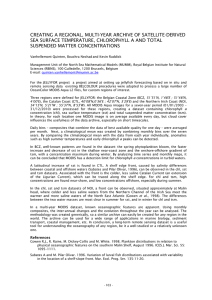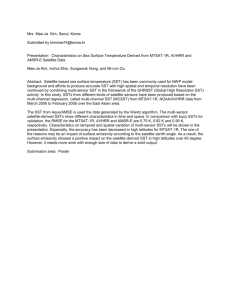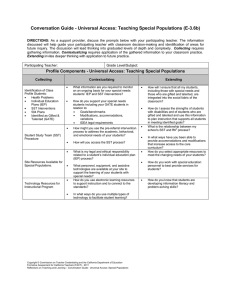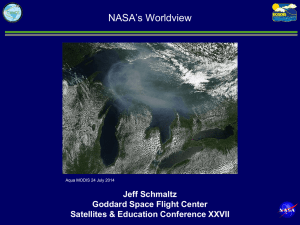NASA / SPoRT Update
advertisement
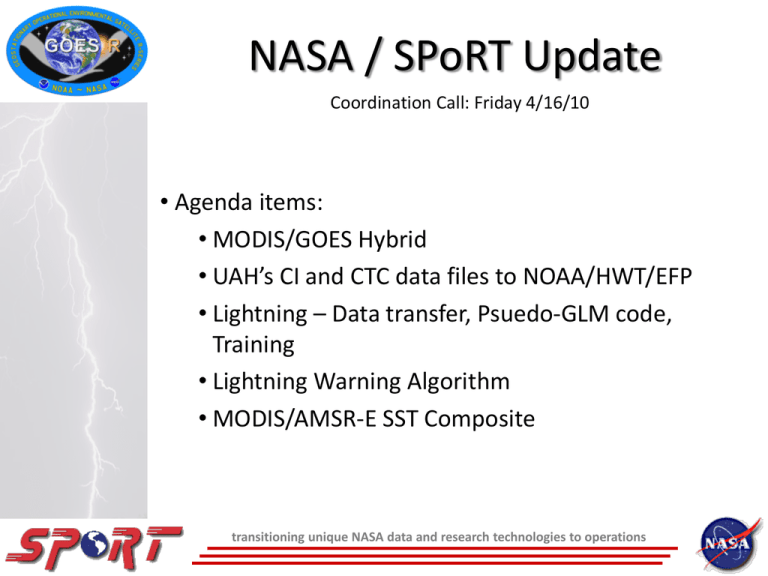
NASA / SPoRT Update Coordination Call: Friday 4/16/10 • Agenda items: • MODIS/GOES Hybrid • UAH’s CI and CTC data files to NOAA/HWT/EFP • Lightning – Data transfer, Psuedo-GLM code, Training • Lightning Warning Algorithm • MODIS/AMSR-E SST Composite transitioning unique NASA data and research technologies to operations MODIS-GOES Hybrid Work done by Gary Jedlovec, Matt Smith, Kevin Fuell • Running in real time, but currently working out the data ingest and bowtie correction logistics for MODIS. • Need to remap MODIS to 2km IR to more accurately portray ABI channels • Need to examine timing discontinuities at edges and possible limb-correction • Product introduced to WFO Partners in March: They expressed high interest. MODIS 1km / GOES 4km IR over SW U.S. at 1845Z (2 MODIS swathes) transitioning unique NASA data and research technologies to operations UAH’s CI and CTC data files to NOAA/HWT/EFP Work by Kevin Fuell, Jon Case, John Walker (UAH), Chris Siewert, Greg Grosshans • NASA/SPoRT asked to assist with the transfer of AWG Convective Initiation and a Cloud Top Cooling product for use during Spring Experiment 2010 • AWG CI product is by University of Alabama Huntsville • SPoRT already sending LMA data in similar fashion • SPoRT worked w/ UAH to make N-AWIPS ready file • HWT has tested a file and will receive automated script from SPoRT and UAH GEMPAK via SPoRT transitioning unique NASA data and research technologies to operations NAWIPS via HWT Real-time KSC Data Work done by Geoffrey Stano, NASA Lightning Group • Lightning group has obtained real-time LDAR data o First successful ingest into AWIPS o Currently at 1 km and 1 min resolution oFinalize ingest to WFO Melbourne, FL during SPoRT visit April 23 o Efforts support Spring Experiment Pseudo-GLM from KSC LDAR II transitioning unique NASA data and research technologies to operations Data Transition Work done by Geoffrey Stano, Kristin Kuhlman • Finalizing data feeds to Spring Experiment o 3 total lightning networks KSC, North Alabama, Washington DC oSPoRT personnel to participate in Experiment • Methodology for Pseudo GLM has been transferred •Providing WES case studies for in-active lightning days o May 3 and 6, 2009 transitioning unique NASA data and research technologies to operations Lightning Training Work done by Geoffrey Stano, Eric Bruning • Train forecasters on the use of the Pseudo GLM product o Intended to be viewed before arriving in Norman Followed by in-person training on first day o Educate forecasters on potential of GLM era o Provide 2 case examples o Working to incorporate into the NWS Learning Management System o transitioning unique NASA data and research technologies to operations WRF-based Lightning Algorithm Work done by Bill McCaul, Jon Case, Scott Dembeck •Ongoing work to use model microphysics to forecast lightning threat (graupel flux, vertically integrated ice) • NSSL WRF has been configured to output Flash Rate Density using hourly max fields. See : •http://www.nssl.noaa.gov/wrf/ o Lightning Threat 1 = based solely on graupel flux o Lightning Threat 2 = based solely on Vert. Integ. Ice o Lightning Threat 3 = combined use of Threats 1 & 2 o Lightning Threat fields will be evaluated at Experimental Forecast Program (EFP) 2010 Tie in with the Proving Ground •Data assimilation from GLM to improve microphysics and storm environment •Better initial characterization of microphysical fields and therefore improved convective forecasts in the very short term (1-6 hours) •Request to use Lightning Threat Algorithm in the simulated WRF-ABI case event transitioning unique NASA data and research technologies to operations Pseudo ABI Composite SST Product Work done by Gary Jedlovec, Frank LaFontaine, Jaclyn Shafer Application •weather forecast community requires continuous spatial coverage of SST for model initialization •marine weather users benefit from high resolution SST data Cloud cover cause a significant problem! MODIS /AMSR-E product relevant to ABI Composite fields of high resolution satellite derived SSTs provide a good way to provide this data Compositing fills in cloudy or data void regions with observations from the previous day(s) satellite passes Fixed time replacement preserves diurnal cycle captured with foursnapshots from polar orbiting data NOAA/GLERL Ice Mask transitioning unique NASA data and research technologies to operations Pseudo ABI Composite SST Product Problem The regional weather forecast community requires continuous spatial fields of surface parameters for model initialization. Composite fields of high resolution satellite derived SSTs may provide a good way to provide this data. However, persistent cloud patterns can cause product latency and reduced accuracy. •Previous work developed a SST composite product with MODIS data to provide high-resolution SST data over limited regions (Haines et al. 2007) •Impact of MODIS SSTs (versus RTG) on fluxes of heat / moisture and subsequent weather forecasts was significant in coastal regions (Lacasse et al. 2008; Case et al. 2009) •Regions of high latency reduced accuracy and impact Single image 12 17 MODIS Composite 22 27 Just finished a collaborative project with PO.DAAC at JPL Developed an enhanced SST composite product – reduced latency •MODIS and AMSR-E, PO.DAAC L2P data stream, latency weighted compositing algorithm Demonstrate improvement and impact on forecasts transitioning unique NASA data and research technologies to operations Pseudo ABI Composite SST Product Approach overview • Increased SST data availability – transition from direct broadcast to more complete data source • Bring in AMSR-E SST data for coverage in persistent cloud regions • SST compositing algorithm changes – latency, error, and resolution weighted product • Use near real-time L2P data stream (JPL) for MODIS and AMSR-E passes more passes – expand product coverage – pixel by pixel quality estimates and bias – slight additional delay in data access – tolerable – better cloud / rain detection – AMSR-E data coarse resolution with no data near coast Coverage of Enhanced MODIS/AMSR-E SST Product transitioning unique NASA data and research technologies to operations Pseudo ABI Composite SST Product Approach details • A collection of MODIS and AMSR-E SST values corresponding to the last 7 days is obtained for the JPL PO.DAAC for each pixel in a product region (at 1 km resolution), for the four Terra / Aqua overpass times – – MODIS proximity flags 4 and 5, bias adjustment AMSR-E proximity flag 4 • Apply latency weighted compositing scheme to the collection at each point in the 1 km resolution output file where SSTcp (I,j) is a composite SST value at a point (I,j), SST(I,j,k) is a SST collection (k is an index corresponding to date of data in collection), L(k) is the latency (in days) of a particular SST value in the collection, and Wt(d,k) is a data weight factor where d corresponds to either MODIS (Wt=1.0), AMSR-E (Wt=0.20), or some other value for another instrument source. • The inverse latency formula uses all data in the collection and allows more recent data to have a greater influence on the composite • The reduced AMSR-E weight factor (Wt) accounts for the large footprint compared to MODIS transitioning unique NASA data and research technologies to operations Pseudo ABI Composite SST Product • MODIS alone produces a high-resolution (1km) SST composite but with some latency issues and gaps • AMSR-E alone reduces latency in the SST composite with coarser resolution data, but not near land • Enhanced MODIS / AMSR-E SST composite a blend of both • Product available 4x a day corresponding to Terra (day and night) and Aqua (day and night) 6-4-07 - Aqua MODIS Day 6-4-07 - Aqua AMSR-E Day MODIS Composite SST AMSR-E Composite SST 6-4-07 – Aqua Day MODIS/AMSR-E MODIS/AMSR-E + OSTIA or NESDIS POES/GOES SST product (with a Wt=0.20) used to fill in where neither MODIS nor AMSR-E coverage is complete (a few coastal areas) transitioning unique NASA data and research technologies to operations Pseudo ABI Composite SST Product Validation 4 regions, 4 seasons, 4 times a day 60-70 fixed buoys (coastal and gradient regions), 90-100 drifting buoys (more open ocean) per time - bias and rms • Enhanced (black) much improved over MODIS only (red) at all times – due to reduced latency • Drifting buoy (solid lines) biases smaller than fixed (dashed) • Biases generally <0.20 C, RMS <0.50 C • Trend in MODIS only due to latency – no trend in enhanced SST composite bias transitioning unique NASA data and research technologies to operations Pseudo ABI Composite SST Product Forecast impact High resolution SSTs have had a positive impact on a forecast applications Enhanced cyclonic flow associated with SST gradient Hurricane WRF forecasts with high resolution SST data show improvements in intensity versus RTG model runs for Hurricane Ike (Courtesy of Dr. Craig Mattocks – UNC). T.S. Claudette, 03z 17 Aug 09 4-h forecast, 10-m wind & MSLP diff WRF EMS 6h forecast by Mobile NWS WFO (using high reso SSTs instead of RTG) for T.S. Claudette (17Aug2009) better depicted location of landfall Impact of high resolution lake temperatures on lake effect snow in WRF EMS transitioning unique NASA data and research technologies to operations Pseudo ABI Composite SST Product - GOES-R PG Application • Current product available in WRF EMS and selected WFOs – 1km resolution (2km in WRF EMS), 4 times a day – Planning to adapt product to GOES ABI resolution – – – – 1-3 hourly, 2 km resolution compare to current POES / GOES once daily product (Maturi) monitor accuracy Eventual dissemination to WFOs, etc. • Will collaborate with AWG on application and use • Positive impact on regional weather forecasts o Real-time data available from NASA / SPoRT (GRIB2) – ftp://ftp.nsstc.org/outgoing/lafonta/sst/grib 2/conus/ o Also available from JPL PO.DAAC in GRIB2 and netCDF (May 2010) o SPoRT – http://weather.msfc.nasa.gov/sport/modis/ sst_comparison.html transitioning unique NASA data and research technologies to operations


